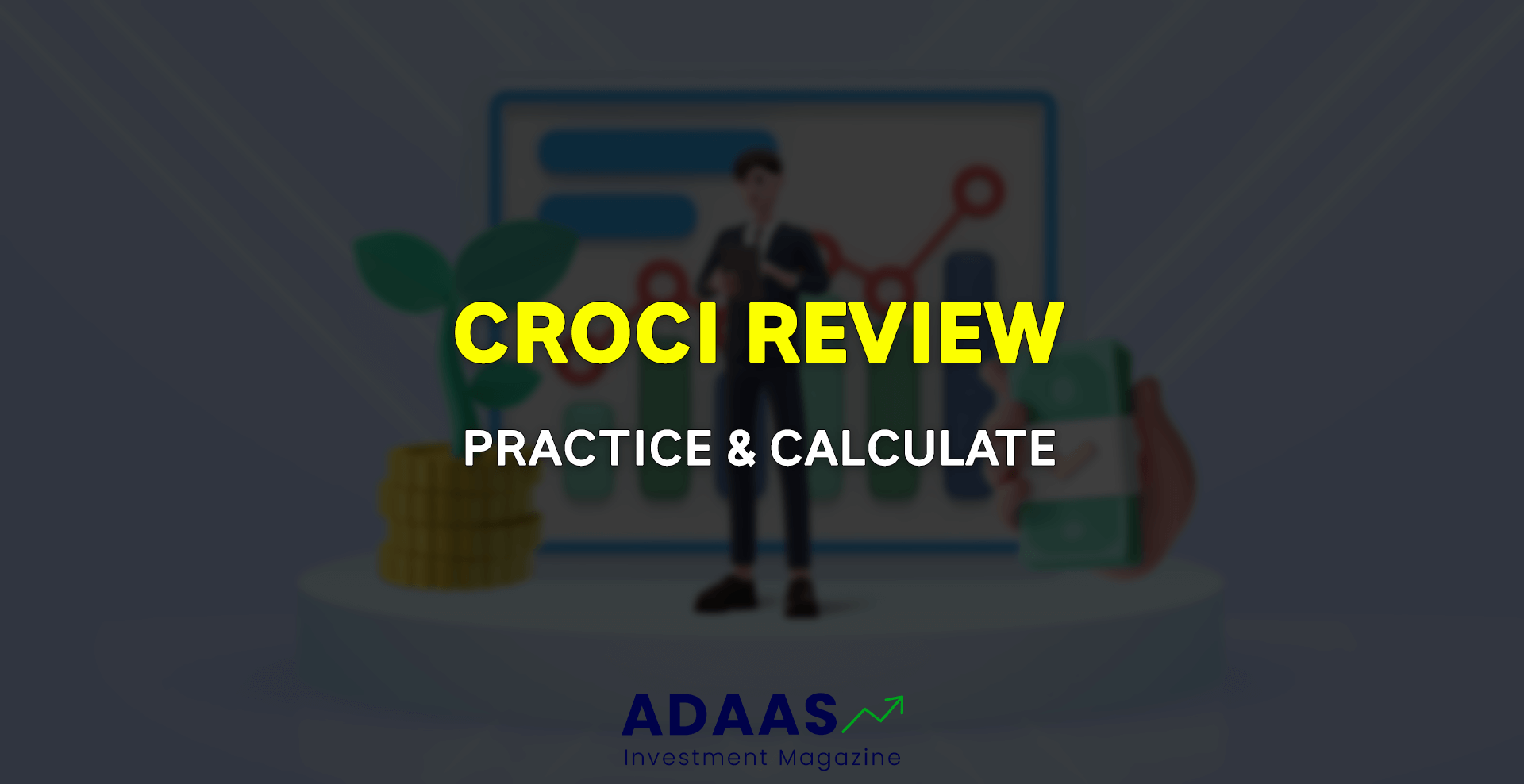CROCI (Cash Return on Capital Invested) Review
A Comprehensive Guide to Calculating and Applying this Powerful Performance Measure.
By reading the article “What is CROCI?” published in Adaas Investment Magazine, you will be fully familiar with all important key metrics and aspects when reviewing Cash Return on Capital Invested! This level of familiarity can be enough when you need educational information about this topic.
Cash Return on Capital Invested (CROCI) is a powerful financial performance measure that helps traders and investors assess how efficiently a company generates cash returns on the capital it has invested in its operations. The concept of CROCI was first developed by HOLT Value Associates in the 1990s as an evolution of the Economic Value Added (EVA) concept, which was developed by the consulting firm Stern Stewart & Co. in the 1980s.
CROCI is an important financial performance measure because it evaluates a company’s profitability and efficiency by considering the actual cash flows generated by its operations, rather than accounting profits. As such, it provides a more accurate representation of a company’s true performance and a reliable benchmark for comparing companies across different industries and markets.
Table of Contents
Understanding CROCI
CROCI is a financial performance metric that measures the cash return on capital invested in a business. It’s a variation of the Economic Value Added (EVA) concept, which seeks to evaluate a company’s ability to generate profits after accounting for the cost of capital. However, unlike EVA, which is calculated using accounting profits, CROCI uses cash flows from operations as the basis for evaluation. This makes it a more accurate representation of a company’s financial performance and provides investors with a better understanding of how efficiently the company is using its capital.
CROCI is different from other financial ratios because it measures the cash returns generated by a company’s operations for every dollar of capital invested, rather than just profits or earnings. This makes it a more comprehensive measure of a company’s financial performance because it considers both the cost of capital and the amount of capital invested in the business. This allows investors to better understand the efficiency of the company’s operations and make more informed investment decisions.
Cash return on capital invested is a useful performance measure for several reasons. It provides a more accurate representation of a company’s financial performance by using cash flows from operations, which are a more reliable indicator of a company’s ability to generate cash returns than accounting profits. CROCI is also useful for comparing companies across different industries and markets because it measures performance based on the amount of capital invested in the business. CROCI is a useful tool for identifying opportunities to optimize cash returns and improve the value of capital invested in a business.
Step-by-Step Guide to Calculating CROCI
Calculating CROCI involves the following steps:
- Determine the capital invested in the business. This includes both debt and equity capital.
- Calculate the weighted average cost of capital (WACC), which represents the cost of the capital invested in the business.
- Calculate the net cash flow from operations, which represents the cash generated by the company’s core business activities after accounting for expenses and taxes.
- Divide the net cash flow from operations by the capital invested to get the CROCI.
The formula for CROCI is:
CROCI = Net Cash Flow from Operations / Capital Invested
Examples of How to Apply CROCI to Different Industries or Businesses
CROCI can be used to evaluate the performance of businesses across a wide range of industries. For example, in the manufacturing industry, it can be used to evaluate the efficiency of a company’s production processes and supply chain management.
In the retail industry, it can be used to evaluate the profitability of a company’s sales and distribution channels.
In the banking industry, CROCI can be used to evaluate the effectiveness of a bank’s lending and investment strategies.
How to Interpret the Results of CROCI Analysis
A high CROCI indicates that a company is generating strong cash returns on its capital invested, while a low CROCI indicates that a company is not generating sufficient returns on its capital.
However, it’s important to consider other factors that may influence a company’s performance, such as market conditions, competitive pressures, and regulatory factors. It is most useful when used in conjunction with other financial and operational metrics to gain a comprehensive understanding of a company’s performance.
Advantages and Disadvantages of CROCI
Using Cash Return On Capital Invested involves the benefits & drawbacks which are:
Advantages of Using for Investment Decisions
1- Accuracy: CROCI is a more accurate representation of a company’s financial performance than other financial ratios because it uses cash flows from operations rather than accounting profits.
2- Consistency: CROCI is consistent across different industries and markets because it measures performance based on the amount of capital invested in the business.
3- Comprehensive: CROCI provides a more comprehensive measure of a company’s financial performance because it considers both the cost of capital and the amount of capital invested in the business.
4- Alignment with Shareholder Value: CROCI is closely aligned with shareholder value because it measures the cash returns generated by a company’s operations for every dollar of capital invested.
Disadvantages and Limitations
1- Data Availability: Calculating CROCI requires detailed financial data that may not always be readily available or may be difficult to obtain.
2- Sensitivity to Assumptions: CROCI is sensitive to the assumptions used in its calculation, such as the cost of capital and the amount of capital invested in the business.
3- Short-Term Focus: CROCI may focus too heavily on short-term cash returns and may not provide a complete picture of a company’s long-term potential.
CROCI is a unique performance measure that provides a more comprehensive view of a company’s financial performance than other financial ratios and measures. For example, while Return on Equity (ROE) and Return on Assets (ROA) provide a measure of a company’s profitability, they do not consider the cost of capital or the amount of capital invested in the business.
Similarly, while Earnings Before Interest, Taxes, Depreciation, and Amortization (EBITDA) provide a measure of a company’s operating performance, it does not consider the cost of capital or the amount of capital invested in the business.
Cash Return On Capital Invested in Practice
Many businesses have used CROCI as a performance measure to improve their financial performance. For example, a telecommunications company used it to evaluate its business segments and focus on those with the highest cash returns. This led to a restructuring of the company’s operations and improved financial performance. Another example is a healthcare company that used CROCI to identify opportunities to optimize its capital structure and improve its financial performance.
In the 1990s, Swiss pharmaceutical company Roche Holdings used Cash Return On Capital Invested to evaluate its business units and make strategic investment decisions. By divesting underperforming business units and investing in areas with higher CROCI, Roche was able to improve its overall financial performance.
In the early 2000s, Brazilian mining company Vale implemented CROCI as a performance metric and used it to identify opportunities for operational improvement. By focusing on increasing the efficiency of its operations and investing in high-return projects, Vale was able to significantly improve its Cash Return On Capital Invested over time.
To use CROCI effectively, investors should consider the following best practices:
1- Ensure data accuracy and availability: Accurate financial data is essential for calculating CROCI, so investors should ensure that the necessary data is available and accurate.
2- Use CROCI in conjunction with other financial and operational metrics: CROCI is most useful when used in conjunction with other financial and operational metrics to gain a comprehensive understanding of a company’s performance.
3- Consider the limitations of CROCI: Investors should be aware of the limitations of CROCI, such as its sensitivity to assumptions and short-term focus.
4- Evaluate CROCI over time: Evaluating CROCI over time can provide insights into a company’s long-term financial performance and potential.
Common Mistakes to Avoid
Investors should be aware of the following common mistakes when using CROCI:
1- Using outdated financial data: Using outdated financial data can lead to inaccurate CROCI calculations and investments.
Using CROCI in isolation: CROCI is most useful when used in conjunction with other financial and operational metrics to gain a comprehensive understanding of a company’s performance.
2- Focusing too heavily on short-term performance: While CROCI provides a measure of a company’s short-term cash returns, investors should also consider a company’s long-term potential and strategic direction.
3- Ignoring the limitations of CROCI: Investors should be aware of the limitations of CROCI and use it as one tool in a comprehensive investment analysis.
Conclusion
Cash Return On Capital Invested is a powerful financial metric that can provide valuable insights into a company’s performance. It measures the cash returns generated by a company’s operations for every dollar of capital invested and provides a clear picture of the company’s ability to generate shareholder value.
One of the key benefits of CROCI is that it provides a more accurate reflection of a company’s true economic profitability than other financial metrics. This is because Cash Return On Capital Invested takes into account both the profitability of a company’s operations and the capital that is required to generate those profits. By doing so, it provides a clearer view of the value that a company is creating for its shareholders.
CROCI also has a number of practical applications. Investors can use it to identify undervalued companies and make more informed investment decisions. Businesses can use it to evaluate the performance of their operations, identify areas for improvement, and make strategic investment decisions.
While CROCI has its limitations, it can be a valuable tool when used in conjunction with other financial and operational metrics. By incorporating best practices and avoiding common mistakes, investors and businesses can use them to make more informed decisions and drive better business performance.
In summary, CROCI is a valuable performance metric that provides a clearer picture of a company’s true economic profitability. By using it, investors and businesses can make more informed decisions and drive better financial performance over the long term.
The End Words
At Adaas Capital, we hope that by reading this article you will be fully immersed in What is CROCI and the key metrics of Cash Return On Capital Invested! You can help us improve by sharing this post which is published in Adaas Investment Magazine and help optimize it by submitting your comments.
References
- “Cash Return on Capital Invested (CROCI).” CFA Institute. Accessed February 19, 2023. www.cfainstitute.org/en/research/foundation/2016/cash-return-on-capital-invested.
- Damodaran, Aswath. Investment Valuation: Tools and Techniques for Determining the Value of any Asset. 3rd ed. Hoboken, NJ: John Wiley & Sons, 2012.
- Franks, Julian, Robert Harris, and Cohn Mayer. “A New Approach to Measuring Financial Performance: Cash Return on Capital Invested.” Journal of Applied Corporate Finance 14, no. 4 (2002): 66-74.
- Graham, Benjamin, and David Dodd. Security Analysis. 6th ed. New York, NY: McGraw-Hill, 2008.
- Hailer, Jeffrey M. “Cash Return on Capital Invested (CROCI): A Better Measure of Profitability.” Journal of Applied Finance 20, no. 1 (2010): 51-59.
- Koller, Tim, Marc Goedhart, and David Wessels. Valuation: Measuring and Managing the Value of Companies. 6th ed. Hoboken, NJ: John Wiley & Sons, 2015.
- Myers, Stewart C. “The Capital Structure Puzzle.” Journal of Finance 39, no. 3 (1984): 575-592.
- Palepu, Krishna G. “The Changing Corporate Landscape.” Journal of Applied Corporate Finance 16, no. 2 (2004): 8-17.
- Penman, Stephen H. Financial Statement Analysis and Security Valuation. 5th ed. New York, NY: McGraw-Hill, 2013.
- “Using Cash Return on Capital Invested to Evaluate Companies.” Harvard Business Review. Accessed February 19, 2023. hbr.org/2002/11/using-cash-return-on-capital-invested-to-evaluate-companies.
FAQ
What is the difference between CROCI and traditional financial ratios?
CROCI focuses on cash flows and considers the amount of capital invested in a business, whereas traditional financial ratios, such as return on assets or return on equity, are based on accounting measures.
How do you calculate CROCI?
CROCI is calculated by dividing a company’s operating cash flow by the total amount of capital invested in the company.







